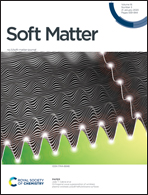Direct observation of the attachment behavior of hydrophobic colloidal particles onto a bubble surface†
Abstract
The attachment of solid particles to the surface of immersed gas bubbles plays a fundamental role in surface science, and hence plays key roles in various engineering fields ranging from industrial separation processes to the fabrication of functional materials. However, detailed investigation from a microscopic view on how a single particle attaches to a bubble surface and how the particle properties affect the attachment behavior has been so far scarcely addressed. Here, we observed the attachment of a single particle to a bubble surface using a high-speed camera and systematically investigated the effects of the wettability and shape of particles. We found that hydrophobic particles abruptly “jumped into” the bubble while sliding down the bubble surface to eventually satisfy their static contact angles, the behavior of which induced a much stronger attachment to the bubble surface. Interestingly, the determinant factor for the attachment efficiency of spherical particles was not the wettability of the spherical particles but the location of the initial collision with the bubble surface. In contrast, the attachment efficiency of anisotropically-shaped particles was found to increase with the hydrophobicity caused by a larger contact area to the bubble surface. Last but not least, a simple formulation is suggested to recover the contact angle based on the jump-in behavior.



 Please wait while we load your content...
Please wait while we load your content...